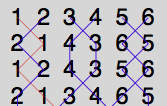27: Removing the falseness (1)
Removing falseness from the first cross section of Treble Bob Hunting is very straightforward. The problem is that, if every pair of bells dodges, then you have automatic falseness. In the case of the first cross-section, the ringing immediately comes back into rounds. The remedy is simple: instead of allowing all the pairs to dodge, we make one of them lie still at the backstroke when the other pairs are dodging.
Which pair do we ask to lie still? Not the trebles. We have already stated that the Treble’s regular treble-bobbing path forms the basis of the vast majority of commonly rung methods. We don’t want to disrupt it by making it lie still. If 5-6 lie still, then we produce the row 123465 at backstroke. Any row ending with 65 at backstroke is considered unmusical, so we avoid it by never allowing the bell in 5ths place to lie still unless the treble is making 6ths. That just leaves 3-4. No problem here. Let’s have them lie still at backstroke. The bells are said to be ‘making places’, in this case, making 3rds and 4ths respectively:

That’s fine. The falseness has gone and, as an nice bonus, the trebles and the tenors are completely unaffected by what’s happened. There is just one small fly in the ointment: the places have flipped 3 and 4 over; the fourth row of the six is not the same as it was previously, and that means that all subsequent rows will be different. In the long term, that might just be an advantage, but for now, we’d like to keep things as simple as possible. Is there a way in which we can expunge the falseness by making places, whilst keeping 3-4 the same way round as before? Happily, yes! The trick is to start the places a blow early, at the opening handstroke, and then to make places again at the following handstroke, like this:

Problem solved.
Kent places and ‘wrong’ places.
- The 3rd makes what are called ‘Kent places out’, i.e. 3rds and 4ths.
- The 4th makes ‘Kent places in’, i.e. 4ths and 3rds.
Notice that the places are made ‘wrong’. Wrong places are places made at backstroke and handstroke, not handstroke and backstroke. You are used to leading and lying ‘right’, i.e handstroke and backstroke. In more advanced ringing, you might be required to lead and lie ‘wrong’, i.e. backstroke and handstroke. Don’t worry, you won’t need to do it for a long time yet!
Near misses.
The places are called Kent places, because that’s how the method called Kent Treble Bob begins. If you go back to the clip from Canterbury Cathedral (in Kent!) in the previous post, you might be able to hear 3 and 4 making places. In particular, listen out for the ‘near miss’ (124356) at the first backstroke. A near miss is defined as any change where just one adjacent pair is crossed in a row which is otherwise rounds. The other near misses on 6 bells are of course: 213456 132456 123546 123465. The number of possible near misses is always one less than the number of bells. For example, on 12 bells, there are 11 near misses.
The effect of the opening Kent places on the trebles and tenors is non-existent. I’ll show you what the work of 3 and 4 looks like with a diagram some other time. For the moment you really don’t need to know.
Removing the falseness from the next two cross-sections is going to require both the trebles and the tenors to modify their work. It’s not difficult, but we won’t try it until we can ring Treble Bob Hunt, with the opening Kent places, perfectly well.



